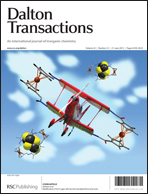Two new inorganic–organic hybrid compounds Na2(C3N2H12)4{[Ni5(OH)3(H2O)4(CH3CO2)][Si2W18O66]}·12.5H2O (1) and (C3N2H12)3{[CoII2CoIII4(OH)5(H2O)2(CH3CO2)][Si2W18O66]}·6H2O·(C3N2H10) (2), based on lacunary polyoxometalates and high-nuclear transition-metal clusters, have been synthesized by a new method (solvothermal method). Single crystal XRD, magnetic measurements, nonlinear-optical (NLO) measurements, thermogravimetric (TG) measurements, and IR spectra were performed to analyze the structures and properties of 1 and 2. XRD analyses reveal that compound 1 consists of an open Wells–Dawson anion [Si2W18O66]16−, a five-nuclear cationic cluster [Ni5(OH)3(H2O)4(CH3CO2)]6+, free Na+ cations, and protonated 1,3-diaminopropanes. Compound 2 has a similar structure to 1, while a six-nuclear cationic cluster [CoII2CoIII4(OH)5(H2O)2(CH3CO2)]10+ replaces the five-nuclear cationic cluster [Ni5(OH)3(H2O)4(CH3CO2)]6+ in 1. Magnetic susceptibility measurements indicate antiferromagnetic interactions in 1, and the chirality of compound 2 may bring potential properties of catalysis and optical nonlinearity.

You have access to this article
 Please wait while we load your content...
Something went wrong. Try again?
Please wait while we load your content...
Something went wrong. Try again?


 Please wait while we load your content...
Please wait while we load your content...